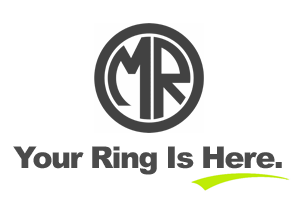Ultimate Guide To Finding Out Your Ring Size

Tessa Hartnett
Men's fashion expert extraordinaire. Over twenty years in the Australian men's fashion and accessories industry.
Quick Summary
- While we have created one of the most (if not the most) comprehensive ring sizing guides in the world here, we really that many people are short on time, so here is a quick summary of the following article.
- Ring sizing around the world comes primarily in two systems. One is alphabetical (eg. J 1/2) and one is numerical (eg. 5.5). While getting measured at a jeweller might seem the most accurate, you can get different results from different jewellers too, depending on how they measure, and even the temperature of the store (as this can affect the swelling of your finger).
- Our number one recommendation is to get a ring sizer from whoever you are ordering your ring from, so that you can measure your ring in the comfort of your home, or even your workplace to get the most accurate measurement.
- We have a free ring sizer that you can order by clicking here. It also comes with a discount!
For those who want to know all of the different options, keep reading below!
Introduction to Ring Sizing
Finding the perfect ring size is crucial for ensuring a comfortable fit and preventing the risk of losing a beloved piece of jewelry. Whether you’re shopping for an engagement ring, a wedding band, or a fashion statement ring, having the correct ring size is essential. In this comprehensive guide, we will take you through a step-by-step process to determine your ring size accurately.
Importance of Knowing Your Ring Size
Wearing a well-fitted ring not only enhances its beauty but also prevents discomfort and potential damage to your finger. A ring that is too tight can constrict blood flow and cause discomfort, while a loose ring may easily slip off your finger, leading to its loss. Additionally, resizing a ring can be costly and may sometimes alter its original design, so it’s best to get the size right from the beginning.
Ring Sizing Systems
There are various ring sizing systems used worldwide, but the two most common ones are the numerical and alphabetical systems. Understanding the system used in your region will be helpful when shopping for rings online or in international markets.
Numerical Sizing: This system is based on numerical measurements, and each size corresponds to a specific circumference or diameter of the finger. The United States typically uses this system, where ring sizes are expressed as whole numbers (e.g., 6, 7, 8) or half-sizes (e.g., 6.5, 7.5, 8.5).
Alphabetical Sizing: In some countries, including the United Kingdom, Australia, and Canada, ring sizes are expressed as letters of the alphabet (e.g., A, B, C, D). Each letter represents a specific size, and the sizing often includes half-sizes as well.
Factors Affecting Ring Size
Several factors can influence the size of your finger and, consequently, your ring size. It’s essential to take these factors into account to ensure an accurate measurement.
Temperature: Finger size can fluctuate depending on the temperature, as fingers tend to be slightly smaller in colder conditions and slightly larger in warmer temperatures. For the most accurate measurement, take your ring size when your fingers are at a comfortable room temperature.
Time of Day: Finger size can also change throughout the day due to activities, water retention, and other factors. To get the most reliable measurement, try to measure your ring size later in the day when your fingers have settled.
Ring Style: The width and thickness of the ring band can affect how the ring fits on your finger. Wider bands generally require a slightly larger size than thinner bands to fit comfortably.
Dominant Hand: If you’re right-handed, your right hand might be slightly larger than your left, and vice versa. Take this into consideration if you intend to wear the ring on your dominant hand.
Medical Conditions: Medical conditions such as arthritis can cause finger swelling, making it necessary to accommodate for these conditions when determining your ring size.
In the following sections, we will explore different methods you can use to find your ring size accurately, including both DIY approaches and professional assistance at jewelry stores. Let’s proceed to Section 2, where we will discuss the DIY methods for measuring your ring size at home.
Section 2: DIY Methods to Measure Your Ring Size at Home
Obtaining an accurate ring size from the comfort of your home is possible with these DIY methods. While these techniques may not be as precise as professional methods, they provide a good starting point for finding your approximate ring size.
Printable Ring Size Chart:
a. Find a Printable Chart: Search online for a reliable printable ring size chart. Many jewelry websites and manufacturers offer downloadable charts that you can print.
b. Calibration: Ensure that the chart is printed to scale by checking the provided measurements on the chart. Some charts may require calibration to a standard ruler.
c. Cut and Measure: Carefully cut out the ring size chart along the dotted lines. Wrap it around your finger and align the marked sizes. Make sure the chart sits comfortably on your finger without being too loose or tight.
d. Read the Size: Take note of the size indicated on the chart where it aligns with the edge. Keep in mind that this method may not be 100% accurate, but it should provide a close approximation.
String or Paper Strip Method:
a. Gather Materials: Prepare a piece of string or a thin strip of paper (about ¼ inch wide) and a ruler.
b. Wrap the String: Wrap the string or paper strip around the base of the finger you want to measure. Make sure it’s snug but not too tight. If you are measuring for a ring that will be worn on your dominant hand, measure that hand’s finger.
c. Mark and Measure: Use a pen to mark the point where the end of the string or paper overlaps the wrapped portion. Carefully remove the string or paper and lay it flat on a table.
d. Measure the Length: Use the ruler to measure the length from the end to the marked point in millimeters or inches. Refer to an online conversion tool if needed.
e. Determine the Size: Compare your measurement to a ring size chart that matches the system used in your region (numerical or alphabetical). The chart will help you identify your ring size based on the measured length.
Adjustable Ring Sizer:
a. Purchase an Adjustable Ring Sizer: Invest in an adjustable ring sizer, which is a small tool designed to slide onto your finger and be tightened to find the perfect fit.
b. Follow Instructions: Most adjustable ring sizers come with simple instructions on how to use them. Place the sizer on your finger and adjust it until it feels comfortable and secure.
c. Note the Size: Read the size indicated on the sizer. It may provide a numerical measurement, an alphabetical letter, or both, depending on the system used.
Using any of these DIY methods should give you a relatively accurate estimate of your ring size. However, keep in mind that for a more precise measurement, it’s best to visit a jewelry store or use a professional ring sizing service. In the next section, we will explore these professional methods in detail.
Section 3: Professional Methods for Accurate Ring Sizing
When it comes to obtaining the most precise and reliable ring size, seeking professional assistance from a jewelry store or a skilled jeweler is highly recommended. Jewelry professionals have access to specialized tools and techniques to measure your ring size accurately. Here are some professional methods for finding your perfect ring size:
Ring Sizing Tool:
a. Multi-Sizer: A multi-sizer is a plastic or metal tool with a series of marked sizes. It works like a belt, sliding easily onto your finger and can be adjusted for a comfortable fit. Jewelers use multi-sizers to determine your size by finding the one that sits snugly on your finger without being too tight.
b. Mandrel: A mandrel is a tapered, cylindrical tool with marked ring sizes. When you visit a jewelry store, the jeweler will gently slide various ring sizes onto the mandrel and assess which one matches the circumference of your finger accurately.
Ring Size Circles or Bands:
a. Ring Size Circles: Some jewelry stores have a set of plastic or metal rings in various sizes. These ring size circles are placed on your finger until the jeweler finds the one that fits perfectly.
b. Ring Size Bands: Similar to the ring size circles, these bands come in various sizes and are made of paper or metal. The jeweler will slide different bands onto your finger to find the right fit.
Digital Ring Sizers:
a. 3D Scanning: Some jewelry stores have advanced 3D scanning technology that precisely measures the size and shape of your finger. This method offers a highly accurate measurement for a custom fit.
b. Optical Sizing Machine: Optical sizing machines use a camera and specialized software to measure your finger and provide precise ring size measurements.
Laser Measuring:
a. Laser Calipers: Laser calipers are used by some jewelers to take highly accurate measurements of your finger, ensuring an exact fit for your ring.
Visiting a Professional Jeweler:
a. Expert Consultation: When you visit a jewelry store, a skilled jeweler will assist you personally, guiding you through the process of finding your ring size. They will consider any unique factors that might affect your size, such as knuckle size or medical conditions.
b. Custom Fitting: Some rings, particularly intricate or wide bands, may require a slightly larger size to fit comfortably. A professional jeweler will consider the style and design of the ring to ensure the best fit.
Remember, it is essential to have your ring size measured under typical conditions, such as room temperature and at a time of day when your fingers are not swollen. Furthermore, it’s a good idea to measure both the finger you intend to wear the ring on and the opposite hand, as they may have slightly different sizes.
In conclusion, knowing your accurate ring size is crucial for comfortable wear and to avoid the inconvenience of resizing or losing a valuable ring. While DIY methods can provide a rough estimate, professional methods are the best option for achieving a precise measurement. Whether you visit a jewelry store or use advanced technology, finding the perfect ring size will ensure your cherished jewelry fits flawlessly and adds a touch of elegance to your style.
